Health Policy Analysis of Water Fluoridation: Kingdon's Framework
VerifiedAdded on 2020/04/21
|14
|3585
|92
Essay
AI Summary
This essay provides a comprehensive analysis of Australia's health policy concerning water fluoridation, employing John Kingdon's multiple streams framework. It explores the problem stream, highlighting the prevalence of dental caries and its impact on various populations, including rural communities and Indigenous Australians. The policy stream is examined, focusing on water fluoridation as a cost-effective intervention and the specific measures outlined in the 'Water fluoridation code for practice.' The political stream is also analyzed, considering legislative acts, government campaigns, and the role of health councils. The essay discusses the implementation and evaluation of the policy, including surveys, environmental considerations, and risk management strategies. Finally, it acknowledges the debate surrounding environmental hazards and suggests alternative strategies, such as addressing potential toxicity issues associated with fluoride.
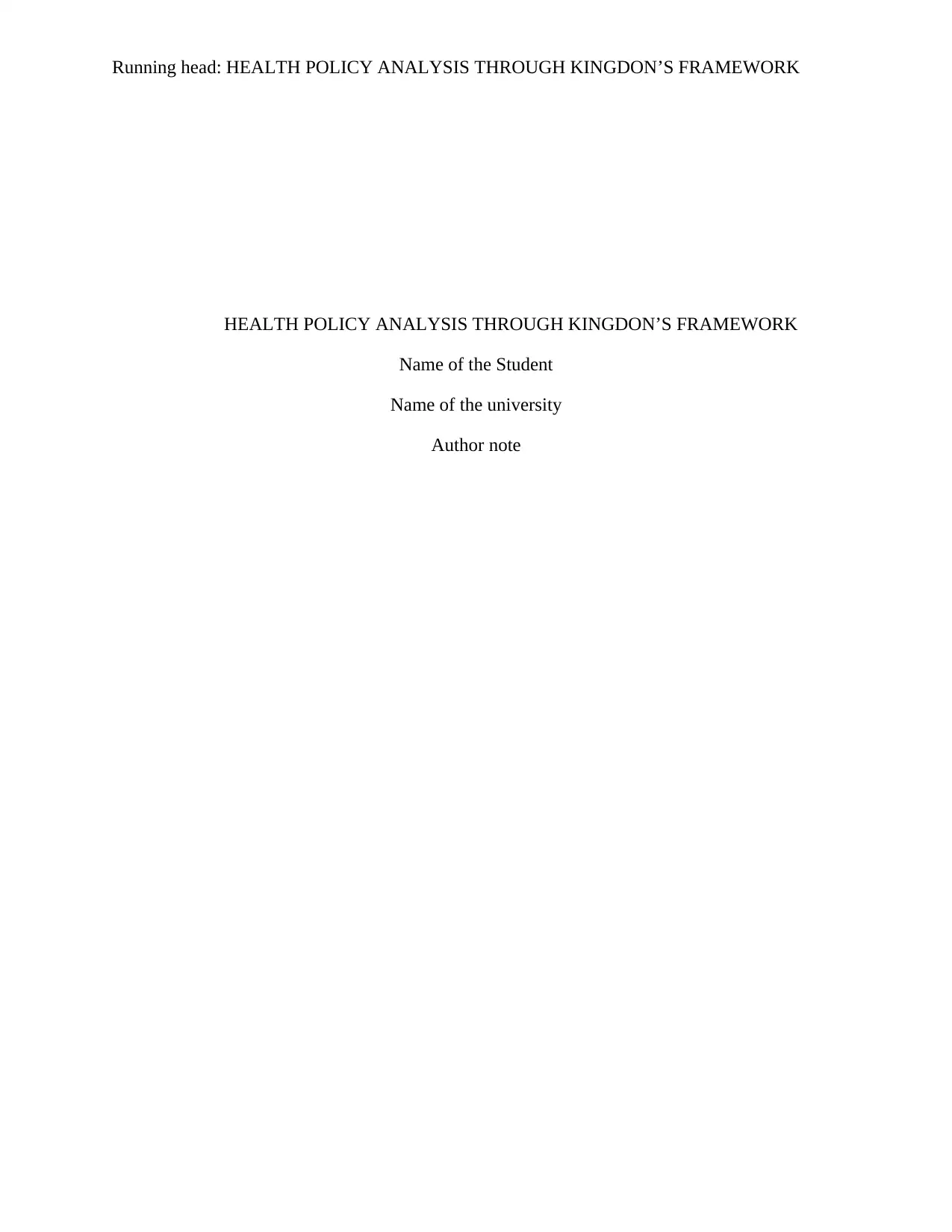
Running head: HEALTH POLICY ANALYSIS THROUGH KINGDON’S FRAMEWORK
HEALTH POLICY ANALYSIS THROUGH KINGDON’S FRAMEWORK
Name of the Student
Name of the university
Author note
HEALTH POLICY ANALYSIS THROUGH KINGDON’S FRAMEWORK
Name of the Student
Name of the university
Author note
Paraphrase This Document
Need a fresh take? Get an instant paraphrase of this document with our AI Paraphraser
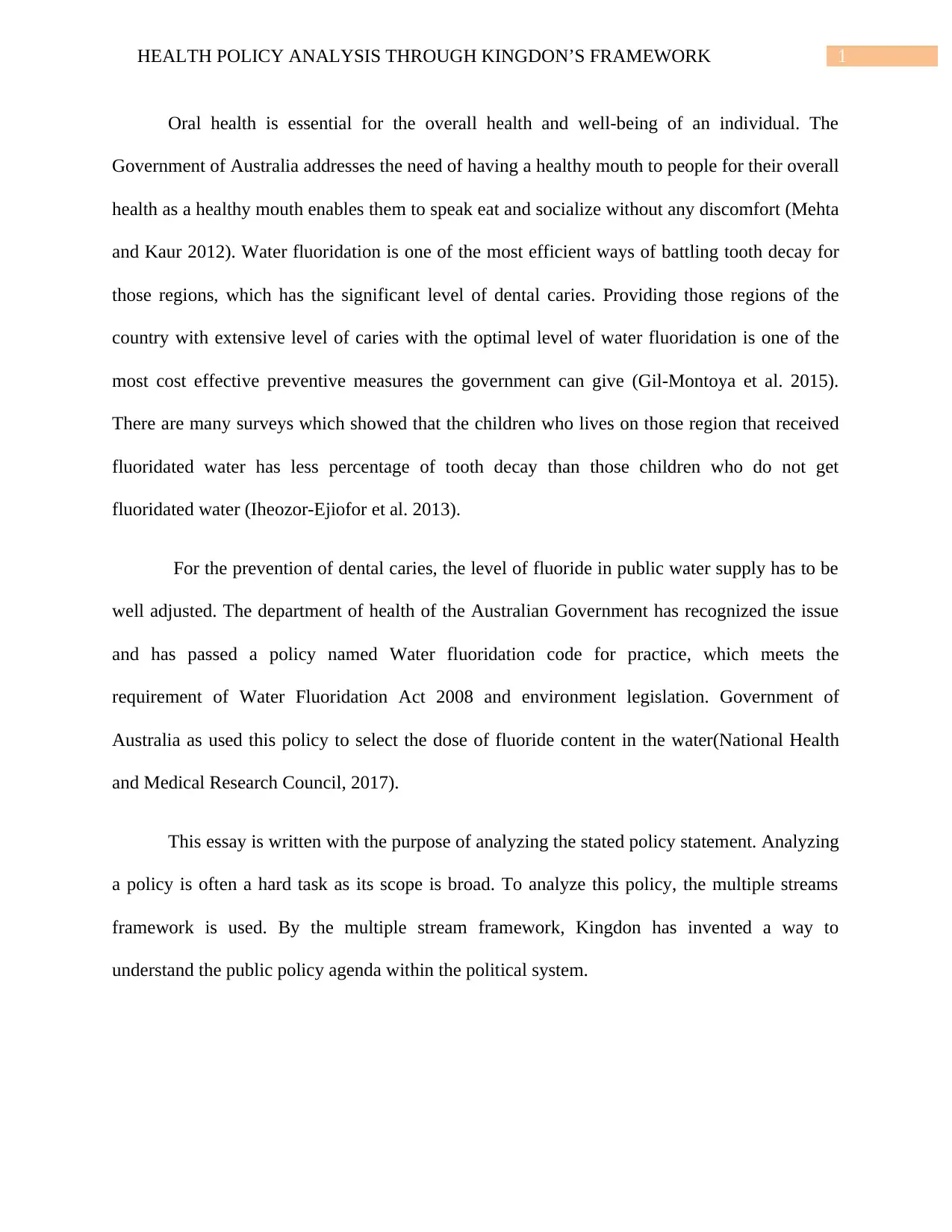
1HEALTH POLICY ANALYSIS THROUGH KINGDON’S FRAMEWORK
Oral health is essential for the overall health and well-being of an individual. The
Government of Australia addresses the need of having a healthy mouth to people for their overall
health as a healthy mouth enables them to speak eat and socialize without any discomfort (Mehta
and Kaur 2012). Water fluoridation is one of the most efficient ways of battling tooth decay for
those regions, which has the significant level of dental caries. Providing those regions of the
country with extensive level of caries with the optimal level of water fluoridation is one of the
most cost effective preventive measures the government can give (Gil-Montoya et al. 2015).
There are many surveys which showed that the children who lives on those region that received
fluoridated water has less percentage of tooth decay than those children who do not get
fluoridated water (Iheozor-Ejiofor et al. 2013).
For the prevention of dental caries, the level of fluoride in public water supply has to be
well adjusted. The department of health of the Australian Government has recognized the issue
and has passed a policy named Water fluoridation code for practice, which meets the
requirement of Water Fluoridation Act 2008 and environment legislation. Government of
Australia as used this policy to select the dose of fluoride content in the water(National Health
and Medical Research Council, 2017).
This essay is written with the purpose of analyzing the stated policy statement. Analyzing
a policy is often a hard task as its scope is broad. To analyze this policy, the multiple streams
framework is used. By the multiple stream framework, Kingdon has invented a way to
understand the public policy agenda within the political system.
Oral health is essential for the overall health and well-being of an individual. The
Government of Australia addresses the need of having a healthy mouth to people for their overall
health as a healthy mouth enables them to speak eat and socialize without any discomfort (Mehta
and Kaur 2012). Water fluoridation is one of the most efficient ways of battling tooth decay for
those regions, which has the significant level of dental caries. Providing those regions of the
country with extensive level of caries with the optimal level of water fluoridation is one of the
most cost effective preventive measures the government can give (Gil-Montoya et al. 2015).
There are many surveys which showed that the children who lives on those region that received
fluoridated water has less percentage of tooth decay than those children who do not get
fluoridated water (Iheozor-Ejiofor et al. 2013).
For the prevention of dental caries, the level of fluoride in public water supply has to be
well adjusted. The department of health of the Australian Government has recognized the issue
and has passed a policy named Water fluoridation code for practice, which meets the
requirement of Water Fluoridation Act 2008 and environment legislation. Government of
Australia as used this policy to select the dose of fluoride content in the water(National Health
and Medical Research Council, 2017).
This essay is written with the purpose of analyzing the stated policy statement. Analyzing
a policy is often a hard task as its scope is broad. To analyze this policy, the multiple streams
framework is used. By the multiple stream framework, Kingdon has invented a way to
understand the public policy agenda within the political system.
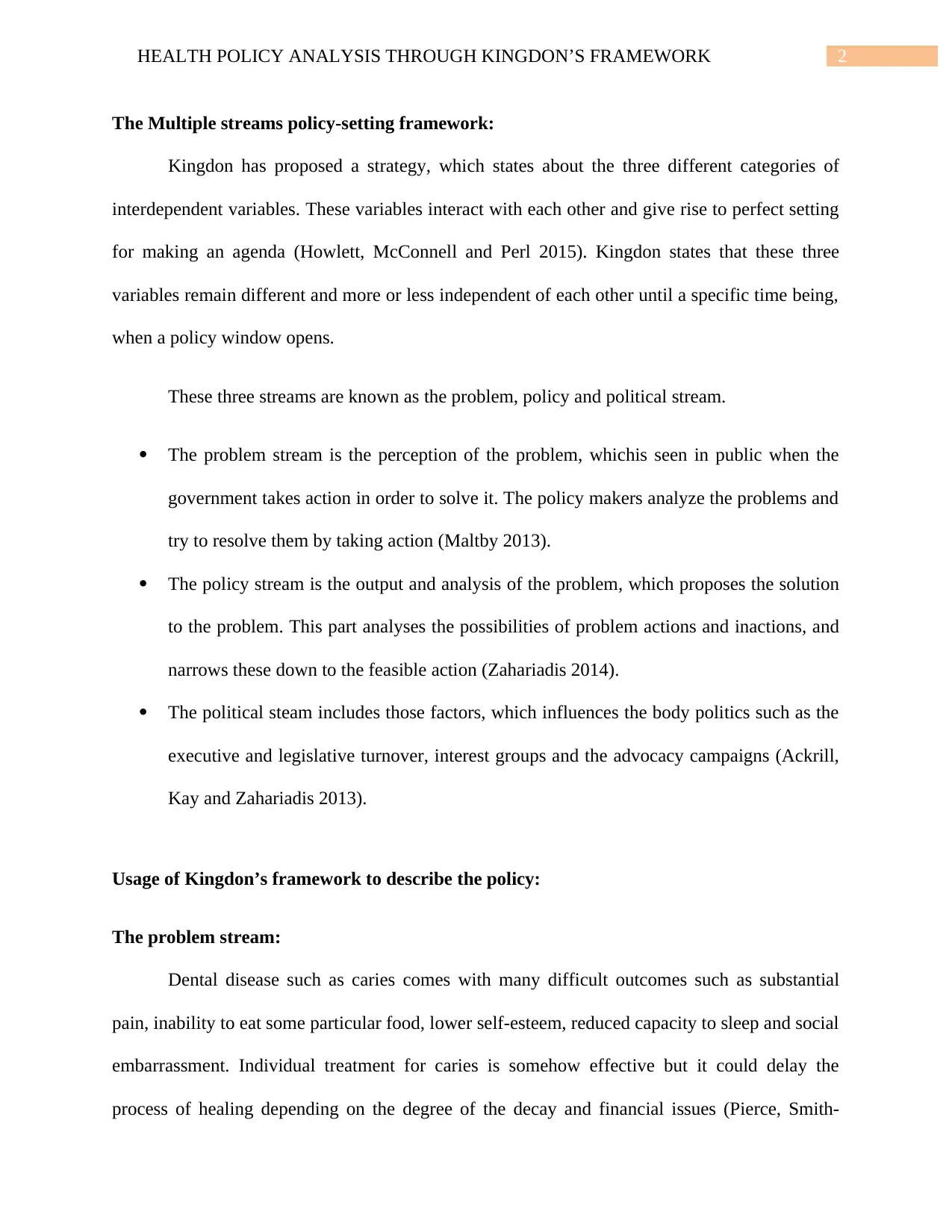
2HEALTH POLICY ANALYSIS THROUGH KINGDON’S FRAMEWORK
The Multiple streams policy-setting framework:
Kingdon has proposed a strategy, which states about the three different categories of
interdependent variables. These variables interact with each other and give rise to perfect setting
for making an agenda (Howlett, McConnell and Perl 2015). Kingdon states that these three
variables remain different and more or less independent of each other until a specific time being,
when a policy window opens.
These three streams are known as the problem, policy and political stream.
The problem stream is the perception of the problem, whichis seen in public when the
government takes action in order to solve it. The policy makers analyze the problems and
try to resolve them by taking action (Maltby 2013).
The policy stream is the output and analysis of the problem, which proposes the solution
to the problem. This part analyses the possibilities of problem actions and inactions, and
narrows these down to the feasible action (Zahariadis 2014).
The political steam includes those factors, which influences the body politics such as the
executive and legislative turnover, interest groups and the advocacy campaigns (Ackrill,
Kay and Zahariadis 2013).
Usage of Kingdon’s framework to describe the policy:
The problem stream:
Dental disease such as caries comes with many difficult outcomes such as substantial
pain, inability to eat some particular food, lower self-esteem, reduced capacity to sleep and social
embarrassment. Individual treatment for caries is somehow effective but it could delay the
process of healing depending on the degree of the decay and financial issues (Pierce, Smith-
The Multiple streams policy-setting framework:
Kingdon has proposed a strategy, which states about the three different categories of
interdependent variables. These variables interact with each other and give rise to perfect setting
for making an agenda (Howlett, McConnell and Perl 2015). Kingdon states that these three
variables remain different and more or less independent of each other until a specific time being,
when a policy window opens.
These three streams are known as the problem, policy and political stream.
The problem stream is the perception of the problem, whichis seen in public when the
government takes action in order to solve it. The policy makers analyze the problems and
try to resolve them by taking action (Maltby 2013).
The policy stream is the output and analysis of the problem, which proposes the solution
to the problem. This part analyses the possibilities of problem actions and inactions, and
narrows these down to the feasible action (Zahariadis 2014).
The political steam includes those factors, which influences the body politics such as the
executive and legislative turnover, interest groups and the advocacy campaigns (Ackrill,
Kay and Zahariadis 2013).
Usage of Kingdon’s framework to describe the policy:
The problem stream:
Dental disease such as caries comes with many difficult outcomes such as substantial
pain, inability to eat some particular food, lower self-esteem, reduced capacity to sleep and social
embarrassment. Individual treatment for caries is somehow effective but it could delay the
process of healing depending on the degree of the decay and financial issues (Pierce, Smith-
⊘ This is a preview!⊘
Do you want full access?
Subscribe today to unlock all pages.

Trusted by 1+ million students worldwide
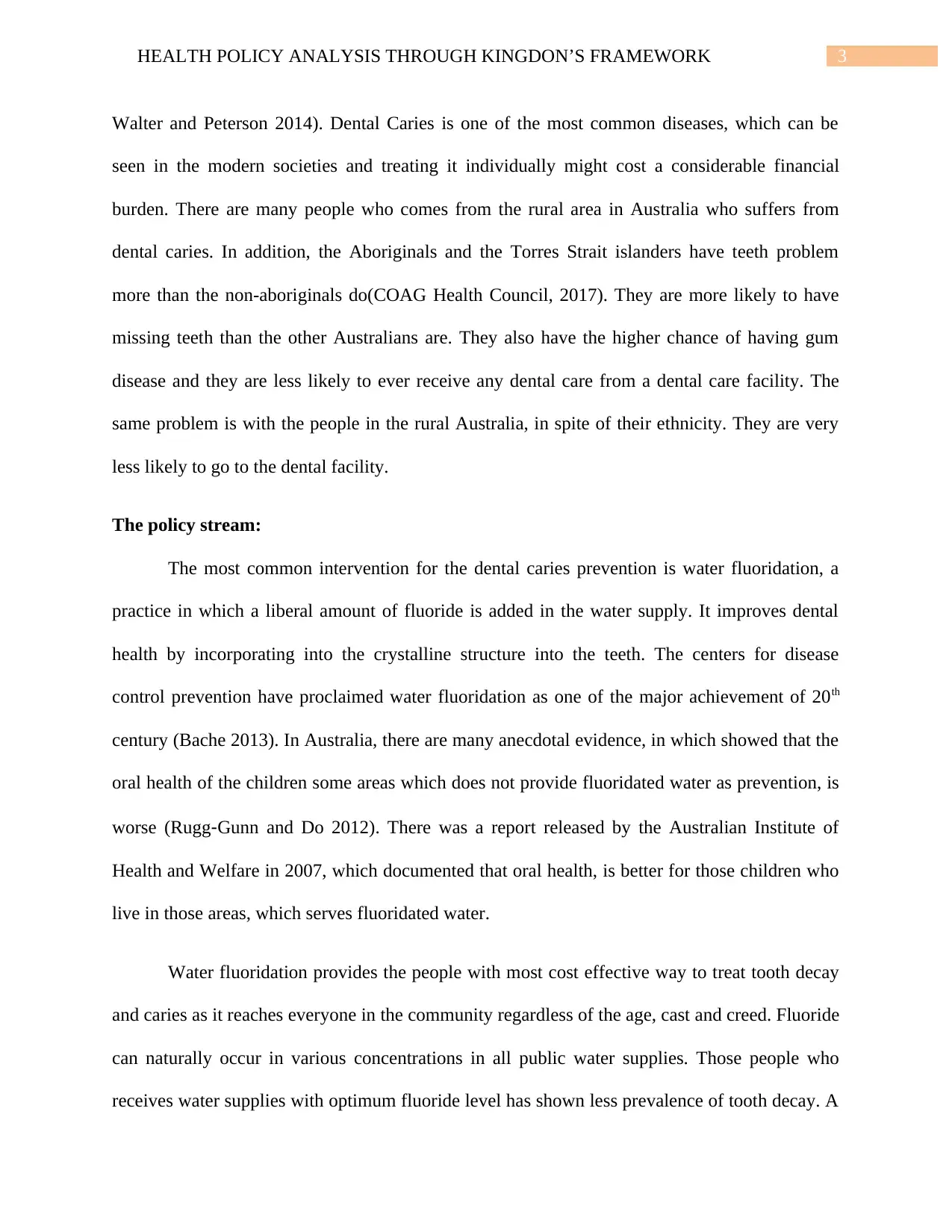
3HEALTH POLICY ANALYSIS THROUGH KINGDON’S FRAMEWORK
Walter and Peterson 2014). Dental Caries is one of the most common diseases, which can be
seen in the modern societies and treating it individually might cost a considerable financial
burden. There are many people who comes from the rural area in Australia who suffers from
dental caries. In addition, the Aboriginals and the Torres Strait islanders have teeth problem
more than the non-aboriginals do(COAG Health Council, 2017). They are more likely to have
missing teeth than the other Australians are. They also have the higher chance of having gum
disease and they are less likely to ever receive any dental care from a dental care facility. The
same problem is with the people in the rural Australia, in spite of their ethnicity. They are very
less likely to go to the dental facility.
The policy stream:
The most common intervention for the dental caries prevention is water fluoridation, a
practice in which a liberal amount of fluoride is added in the water supply. It improves dental
health by incorporating into the crystalline structure into the teeth. The centers for disease
control prevention have proclaimed water fluoridation as one of the major achievement of 20th
century (Bache 2013). In Australia, there are many anecdotal evidence, in which showed that the
oral health of the children some areas which does not provide fluoridated water as prevention, is
worse (Rugg‐Gunn and Do 2012). There was a report released by the Australian Institute of
Health and Welfare in 2007, which documented that oral health, is better for those children who
live in those areas, which serves fluoridated water.
Water fluoridation provides the people with most cost effective way to treat tooth decay
and caries as it reaches everyone in the community regardless of the age, cast and creed. Fluoride
can naturally occur in various concentrations in all public water supplies. Those people who
receives water supplies with optimum fluoride level has shown less prevalence of tooth decay. A
Walter and Peterson 2014). Dental Caries is one of the most common diseases, which can be
seen in the modern societies and treating it individually might cost a considerable financial
burden. There are many people who comes from the rural area in Australia who suffers from
dental caries. In addition, the Aboriginals and the Torres Strait islanders have teeth problem
more than the non-aboriginals do(COAG Health Council, 2017). They are more likely to have
missing teeth than the other Australians are. They also have the higher chance of having gum
disease and they are less likely to ever receive any dental care from a dental care facility. The
same problem is with the people in the rural Australia, in spite of their ethnicity. They are very
less likely to go to the dental facility.
The policy stream:
The most common intervention for the dental caries prevention is water fluoridation, a
practice in which a liberal amount of fluoride is added in the water supply. It improves dental
health by incorporating into the crystalline structure into the teeth. The centers for disease
control prevention have proclaimed water fluoridation as one of the major achievement of 20th
century (Bache 2013). In Australia, there are many anecdotal evidence, in which showed that the
oral health of the children some areas which does not provide fluoridated water as prevention, is
worse (Rugg‐Gunn and Do 2012). There was a report released by the Australian Institute of
Health and Welfare in 2007, which documented that oral health, is better for those children who
live in those areas, which serves fluoridated water.
Water fluoridation provides the people with most cost effective way to treat tooth decay
and caries as it reaches everyone in the community regardless of the age, cast and creed. Fluoride
can naturally occur in various concentrations in all public water supplies. Those people who
receives water supplies with optimum fluoride level has shown less prevalence of tooth decay. A
Paraphrase This Document
Need a fresh take? Get an instant paraphrase of this document with our AI Paraphraser
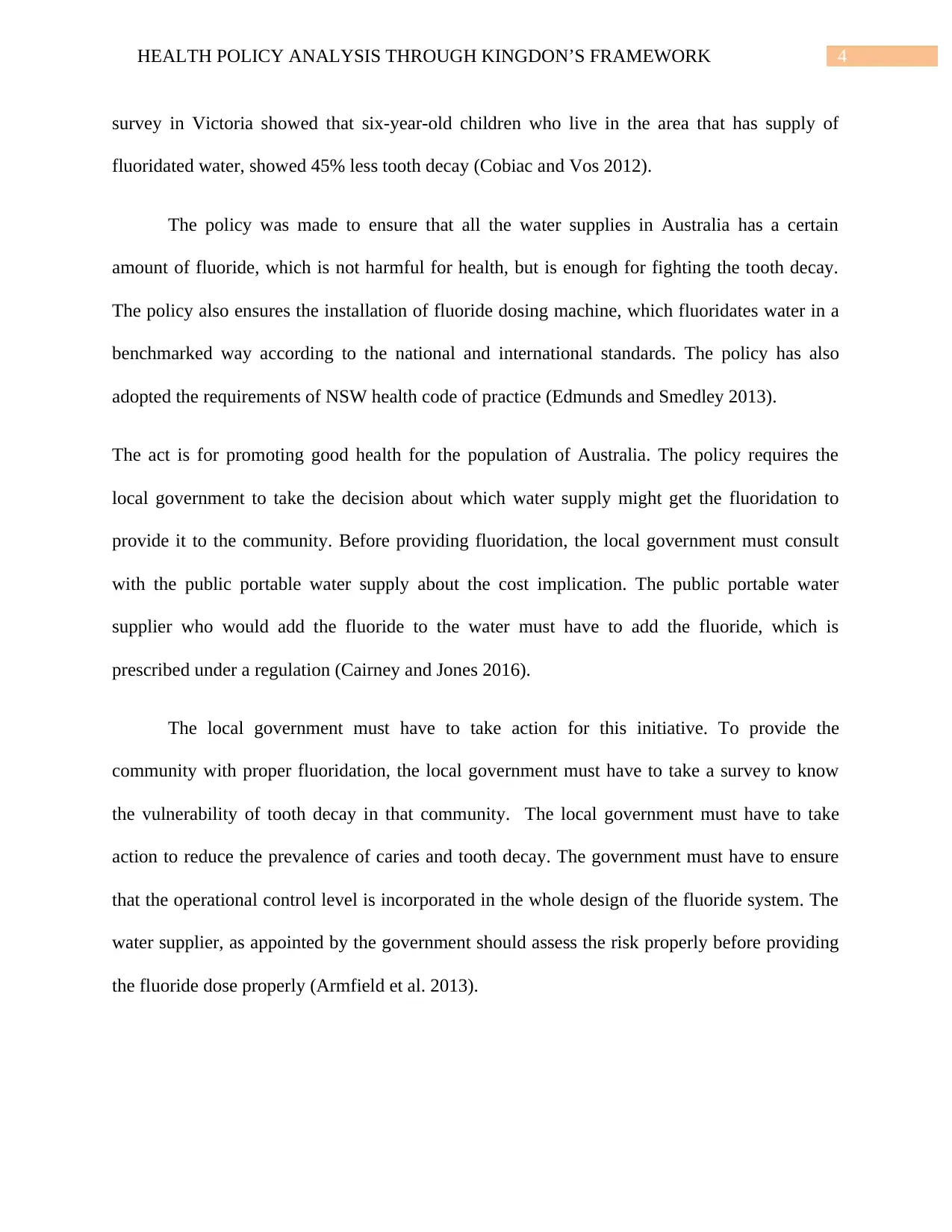
4HEALTH POLICY ANALYSIS THROUGH KINGDON’S FRAMEWORK
survey in Victoria showed that six-year-old children who live in the area that has supply of
fluoridated water, showed 45% less tooth decay (Cobiac and Vos 2012).
The policy was made to ensure that all the water supplies in Australia has a certain
amount of fluoride, which is not harmful for health, but is enough for fighting the tooth decay.
The policy also ensures the installation of fluoride dosing machine, which fluoridates water in a
benchmarked way according to the national and international standards. The policy has also
adopted the requirements of NSW health code of practice (Edmunds and Smedley 2013).
The act is for promoting good health for the population of Australia. The policy requires the
local government to take the decision about which water supply might get the fluoridation to
provide it to the community. Before providing fluoridation, the local government must consult
with the public portable water supply about the cost implication. The public portable water
supplier who would add the fluoride to the water must have to add the fluoride, which is
prescribed under a regulation (Cairney and Jones 2016).
The local government must have to take action for this initiative. To provide the
community with proper fluoridation, the local government must have to take a survey to know
the vulnerability of tooth decay in that community. The local government must have to take
action to reduce the prevalence of caries and tooth decay. The government must have to ensure
that the operational control level is incorporated in the whole design of the fluoride system. The
water supplier, as appointed by the government should assess the risk properly before providing
the fluoride dose properly (Armfield et al. 2013).
survey in Victoria showed that six-year-old children who live in the area that has supply of
fluoridated water, showed 45% less tooth decay (Cobiac and Vos 2012).
The policy was made to ensure that all the water supplies in Australia has a certain
amount of fluoride, which is not harmful for health, but is enough for fighting the tooth decay.
The policy also ensures the installation of fluoride dosing machine, which fluoridates water in a
benchmarked way according to the national and international standards. The policy has also
adopted the requirements of NSW health code of practice (Edmunds and Smedley 2013).
The act is for promoting good health for the population of Australia. The policy requires the
local government to take the decision about which water supply might get the fluoridation to
provide it to the community. Before providing fluoridation, the local government must consult
with the public portable water supply about the cost implication. The public portable water
supplier who would add the fluoride to the water must have to add the fluoride, which is
prescribed under a regulation (Cairney and Jones 2016).
The local government must have to take action for this initiative. To provide the
community with proper fluoridation, the local government must have to take a survey to know
the vulnerability of tooth decay in that community. The local government must have to take
action to reduce the prevalence of caries and tooth decay. The government must have to ensure
that the operational control level is incorporated in the whole design of the fluoride system. The
water supplier, as appointed by the government should assess the risk properly before providing
the fluoride dose properly (Armfield et al. 2013).
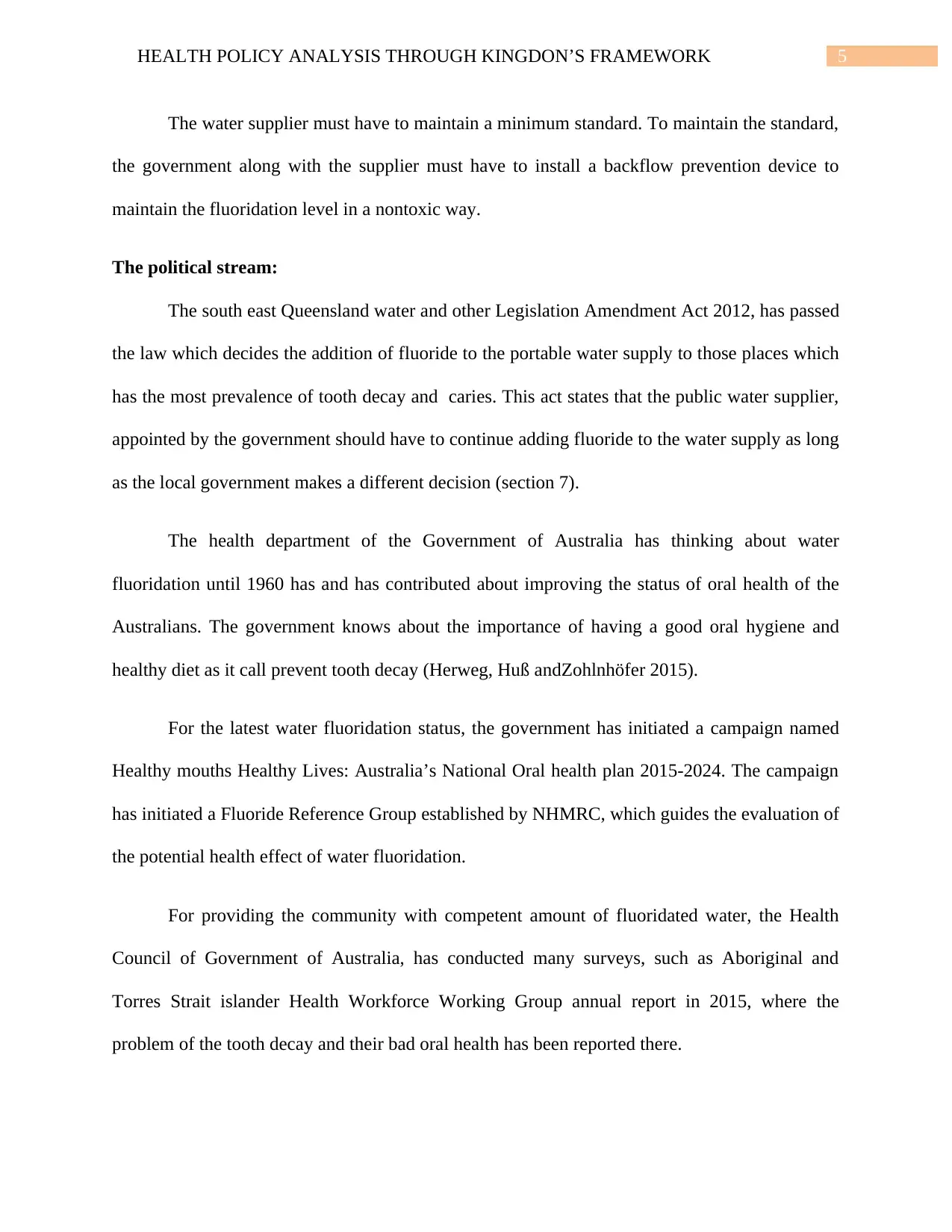
5HEALTH POLICY ANALYSIS THROUGH KINGDON’S FRAMEWORK
The water supplier must have to maintain a minimum standard. To maintain the standard,
the government along with the supplier must have to install a backflow prevention device to
maintain the fluoridation level in a nontoxic way.
The political stream:
The south east Queensland water and other Legislation Amendment Act 2012, has passed
the law which decides the addition of fluoride to the portable water supply to those places which
has the most prevalence of tooth decay and caries. This act states that the public water supplier,
appointed by the government should have to continue adding fluoride to the water supply as long
as the local government makes a different decision (section 7).
The health department of the Government of Australia has thinking about water
fluoridation until 1960 has and has contributed about improving the status of oral health of the
Australians. The government knows about the importance of having a good oral hygiene and
healthy diet as it call prevent tooth decay (Herweg, Huß andZohlnhöfer 2015).
For the latest water fluoridation status, the government has initiated a campaign named
Healthy mouths Healthy Lives: Australia’s National Oral health plan 2015-2024. The campaign
has initiated a Fluoride Reference Group established by NHMRC, which guides the evaluation of
the potential health effect of water fluoridation.
For providing the community with competent amount of fluoridated water, the Health
Council of Government of Australia, has conducted many surveys, such as Aboriginal and
Torres Strait islander Health Workforce Working Group annual report in 2015, where the
problem of the tooth decay and their bad oral health has been reported there.
The water supplier must have to maintain a minimum standard. To maintain the standard,
the government along with the supplier must have to install a backflow prevention device to
maintain the fluoridation level in a nontoxic way.
The political stream:
The south east Queensland water and other Legislation Amendment Act 2012, has passed
the law which decides the addition of fluoride to the portable water supply to those places which
has the most prevalence of tooth decay and caries. This act states that the public water supplier,
appointed by the government should have to continue adding fluoride to the water supply as long
as the local government makes a different decision (section 7).
The health department of the Government of Australia has thinking about water
fluoridation until 1960 has and has contributed about improving the status of oral health of the
Australians. The government knows about the importance of having a good oral hygiene and
healthy diet as it call prevent tooth decay (Herweg, Huß andZohlnhöfer 2015).
For the latest water fluoridation status, the government has initiated a campaign named
Healthy mouths Healthy Lives: Australia’s National Oral health plan 2015-2024. The campaign
has initiated a Fluoride Reference Group established by NHMRC, which guides the evaluation of
the potential health effect of water fluoridation.
For providing the community with competent amount of fluoridated water, the Health
Council of Government of Australia, has conducted many surveys, such as Aboriginal and
Torres Strait islander Health Workforce Working Group annual report in 2015, where the
problem of the tooth decay and their bad oral health has been reported there.
⊘ This is a preview!⊘
Do you want full access?
Subscribe today to unlock all pages.

Trusted by 1+ million students worldwide
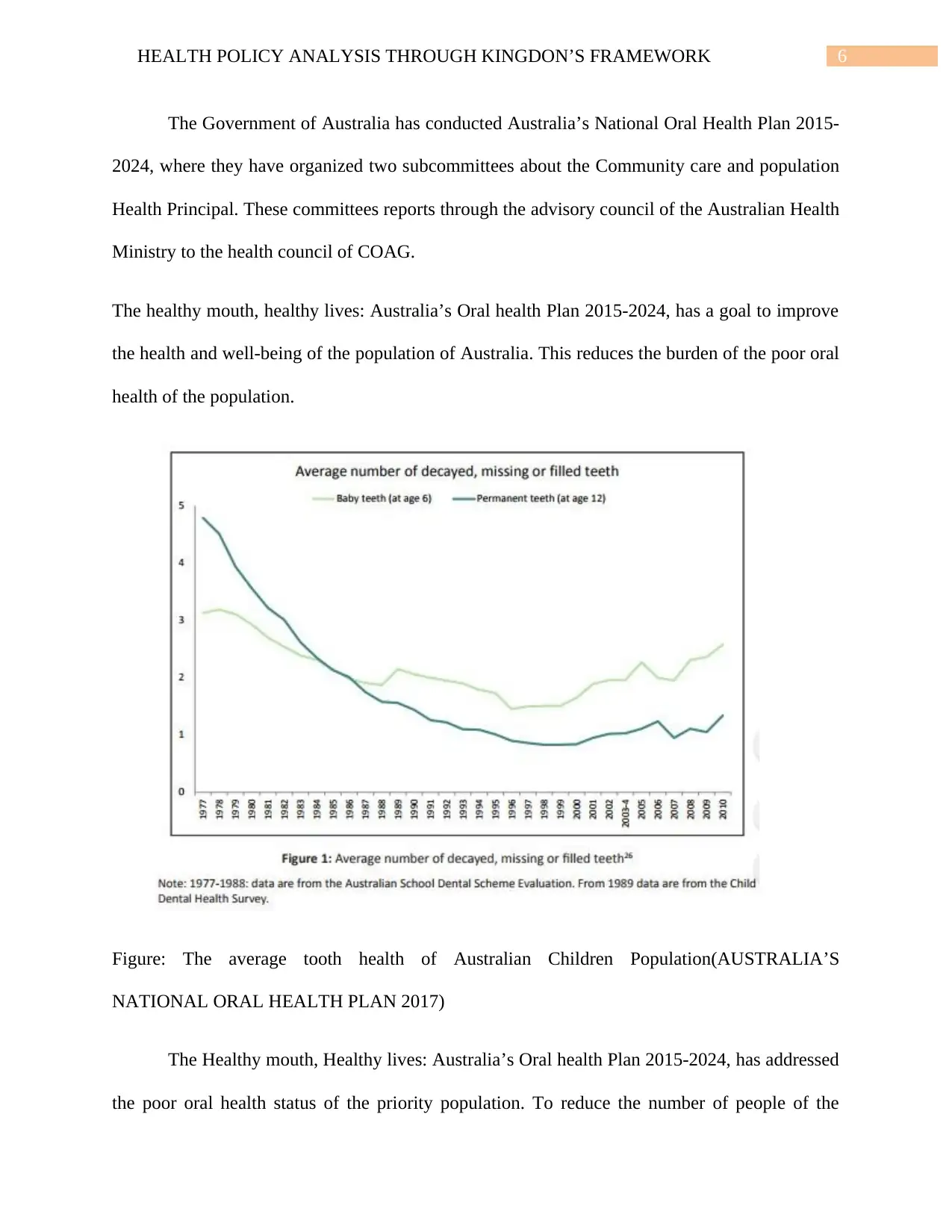
6HEALTH POLICY ANALYSIS THROUGH KINGDON’S FRAMEWORK
The Government of Australia has conducted Australia’s National Oral Health Plan 2015-
2024, where they have organized two subcommittees about the Community care and population
Health Principal. These committees reports through the advisory council of the Australian Health
Ministry to the health council of COAG.
The healthy mouth, healthy lives: Australia’s Oral health Plan 2015-2024, has a goal to improve
the health and well-being of the population of Australia. This reduces the burden of the poor oral
health of the population.
Figure: The average tooth health of Australian Children Population(AUSTRALIA’S
NATIONAL ORAL HEALTH PLAN 2017)
The Healthy mouth, Healthy lives: Australia’s Oral health Plan 2015-2024, has addressed
the poor oral health status of the priority population. To reduce the number of people of the
The Government of Australia has conducted Australia’s National Oral Health Plan 2015-
2024, where they have organized two subcommittees about the Community care and population
Health Principal. These committees reports through the advisory council of the Australian Health
Ministry to the health council of COAG.
The healthy mouth, healthy lives: Australia’s Oral health Plan 2015-2024, has a goal to improve
the health and well-being of the population of Australia. This reduces the burden of the poor oral
health of the population.
Figure: The average tooth health of Australian Children Population(AUSTRALIA’S
NATIONAL ORAL HEALTH PLAN 2017)
The Healthy mouth, Healthy lives: Australia’s Oral health Plan 2015-2024, has addressed
the poor oral health status of the priority population. To reduce the number of people of the
Paraphrase This Document
Need a fresh take? Get an instant paraphrase of this document with our AI Paraphraser
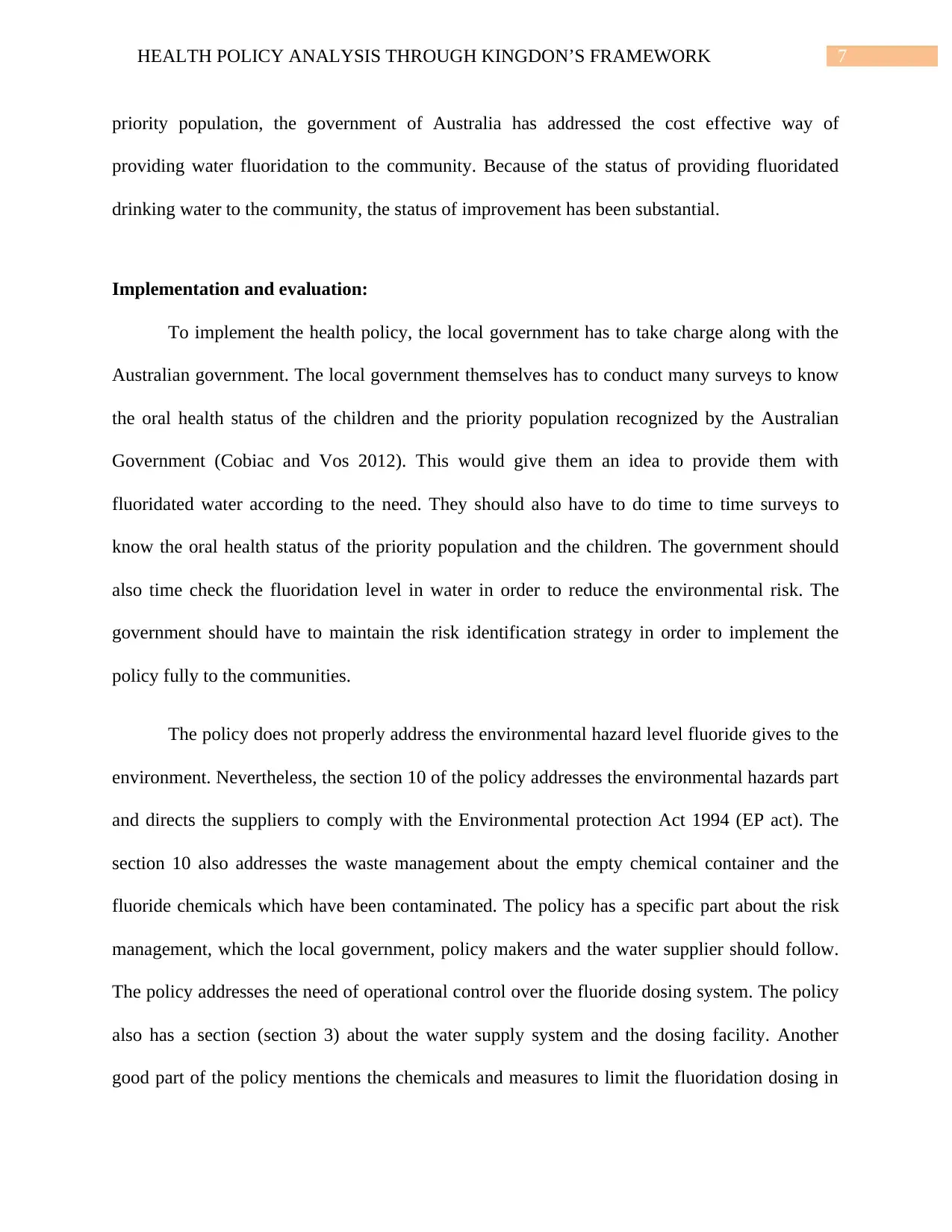
7HEALTH POLICY ANALYSIS THROUGH KINGDON’S FRAMEWORK
priority population, the government of Australia has addressed the cost effective way of
providing water fluoridation to the community. Because of the status of providing fluoridated
drinking water to the community, the status of improvement has been substantial.
Implementation and evaluation:
To implement the health policy, the local government has to take charge along with the
Australian government. The local government themselves has to conduct many surveys to know
the oral health status of the children and the priority population recognized by the Australian
Government (Cobiac and Vos 2012). This would give them an idea to provide them with
fluoridated water according to the need. They should also have to do time to time surveys to
know the oral health status of the priority population and the children. The government should
also time check the fluoridation level in water in order to reduce the environmental risk. The
government should have to maintain the risk identification strategy in order to implement the
policy fully to the communities.
The policy does not properly address the environmental hazard level fluoride gives to the
environment. Nevertheless, the section 10 of the policy addresses the environmental hazards part
and directs the suppliers to comply with the Environmental protection Act 1994 (EP act). The
section 10 also addresses the waste management about the empty chemical container and the
fluoride chemicals which have been contaminated. The policy has a specific part about the risk
management, which the local government, policy makers and the water supplier should follow.
The policy addresses the need of operational control over the fluoride dosing system. The policy
also has a section (section 3) about the water supply system and the dosing facility. Another
good part of the policy mentions the chemicals and measures to limit the fluoridation dosing in
priority population, the government of Australia has addressed the cost effective way of
providing water fluoridation to the community. Because of the status of providing fluoridated
drinking water to the community, the status of improvement has been substantial.
Implementation and evaluation:
To implement the health policy, the local government has to take charge along with the
Australian government. The local government themselves has to conduct many surveys to know
the oral health status of the children and the priority population recognized by the Australian
Government (Cobiac and Vos 2012). This would give them an idea to provide them with
fluoridated water according to the need. They should also have to do time to time surveys to
know the oral health status of the priority population and the children. The government should
also time check the fluoridation level in water in order to reduce the environmental risk. The
government should have to maintain the risk identification strategy in order to implement the
policy fully to the communities.
The policy does not properly address the environmental hazard level fluoride gives to the
environment. Nevertheless, the section 10 of the policy addresses the environmental hazards part
and directs the suppliers to comply with the Environmental protection Act 1994 (EP act). The
section 10 also addresses the waste management about the empty chemical container and the
fluoride chemicals which have been contaminated. The policy has a specific part about the risk
management, which the local government, policy makers and the water supplier should follow.
The policy addresses the need of operational control over the fluoride dosing system. The policy
also has a section (section 3) about the water supply system and the dosing facility. Another
good part of the policy mentions the chemicals and measures to limit the fluoridation dosing in
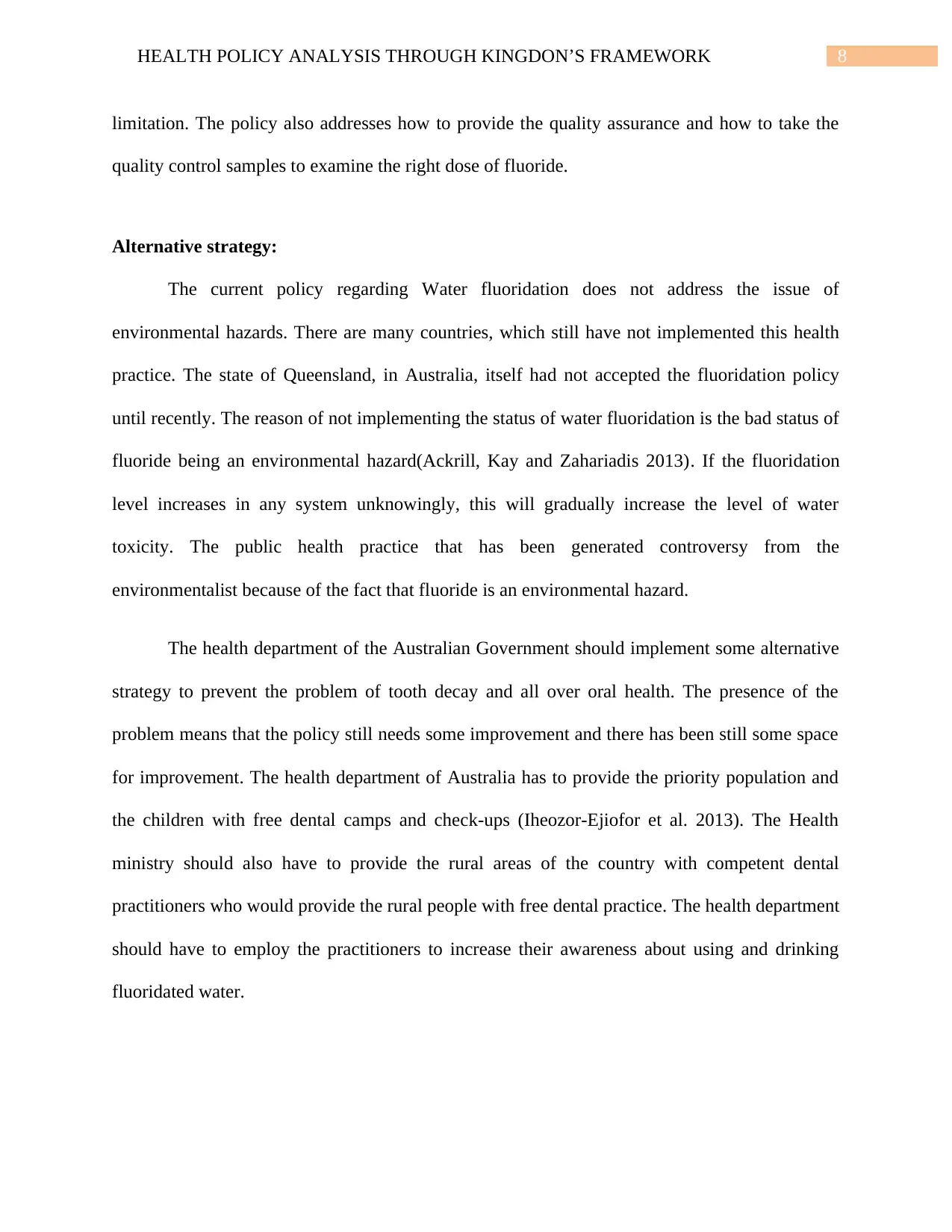
8HEALTH POLICY ANALYSIS THROUGH KINGDON’S FRAMEWORK
limitation. The policy also addresses how to provide the quality assurance and how to take the
quality control samples to examine the right dose of fluoride.
Alternative strategy:
The current policy regarding Water fluoridation does not address the issue of
environmental hazards. There are many countries, which still have not implemented this health
practice. The state of Queensland, in Australia, itself had not accepted the fluoridation policy
until recently. The reason of not implementing the status of water fluoridation is the bad status of
fluoride being an environmental hazard(Ackrill, Kay and Zahariadis 2013). If the fluoridation
level increases in any system unknowingly, this will gradually increase the level of water
toxicity. The public health practice that has been generated controversy from the
environmentalist because of the fact that fluoride is an environmental hazard.
The health department of the Australian Government should implement some alternative
strategy to prevent the problem of tooth decay and all over oral health. The presence of the
problem means that the policy still needs some improvement and there has been still some space
for improvement. The health department of Australia has to provide the priority population and
the children with free dental camps and check-ups (Iheozor-Ejiofor et al. 2013). The Health
ministry should also have to provide the rural areas of the country with competent dental
practitioners who would provide the rural people with free dental practice. The health department
should have to employ the practitioners to increase their awareness about using and drinking
fluoridated water.
limitation. The policy also addresses how to provide the quality assurance and how to take the
quality control samples to examine the right dose of fluoride.
Alternative strategy:
The current policy regarding Water fluoridation does not address the issue of
environmental hazards. There are many countries, which still have not implemented this health
practice. The state of Queensland, in Australia, itself had not accepted the fluoridation policy
until recently. The reason of not implementing the status of water fluoridation is the bad status of
fluoride being an environmental hazard(Ackrill, Kay and Zahariadis 2013). If the fluoridation
level increases in any system unknowingly, this will gradually increase the level of water
toxicity. The public health practice that has been generated controversy from the
environmentalist because of the fact that fluoride is an environmental hazard.
The health department of the Australian Government should implement some alternative
strategy to prevent the problem of tooth decay and all over oral health. The presence of the
problem means that the policy still needs some improvement and there has been still some space
for improvement. The health department of Australia has to provide the priority population and
the children with free dental camps and check-ups (Iheozor-Ejiofor et al. 2013). The Health
ministry should also have to provide the rural areas of the country with competent dental
practitioners who would provide the rural people with free dental practice. The health department
should have to employ the practitioners to increase their awareness about using and drinking
fluoridated water.
⊘ This is a preview!⊘
Do you want full access?
Subscribe today to unlock all pages.

Trusted by 1+ million students worldwide
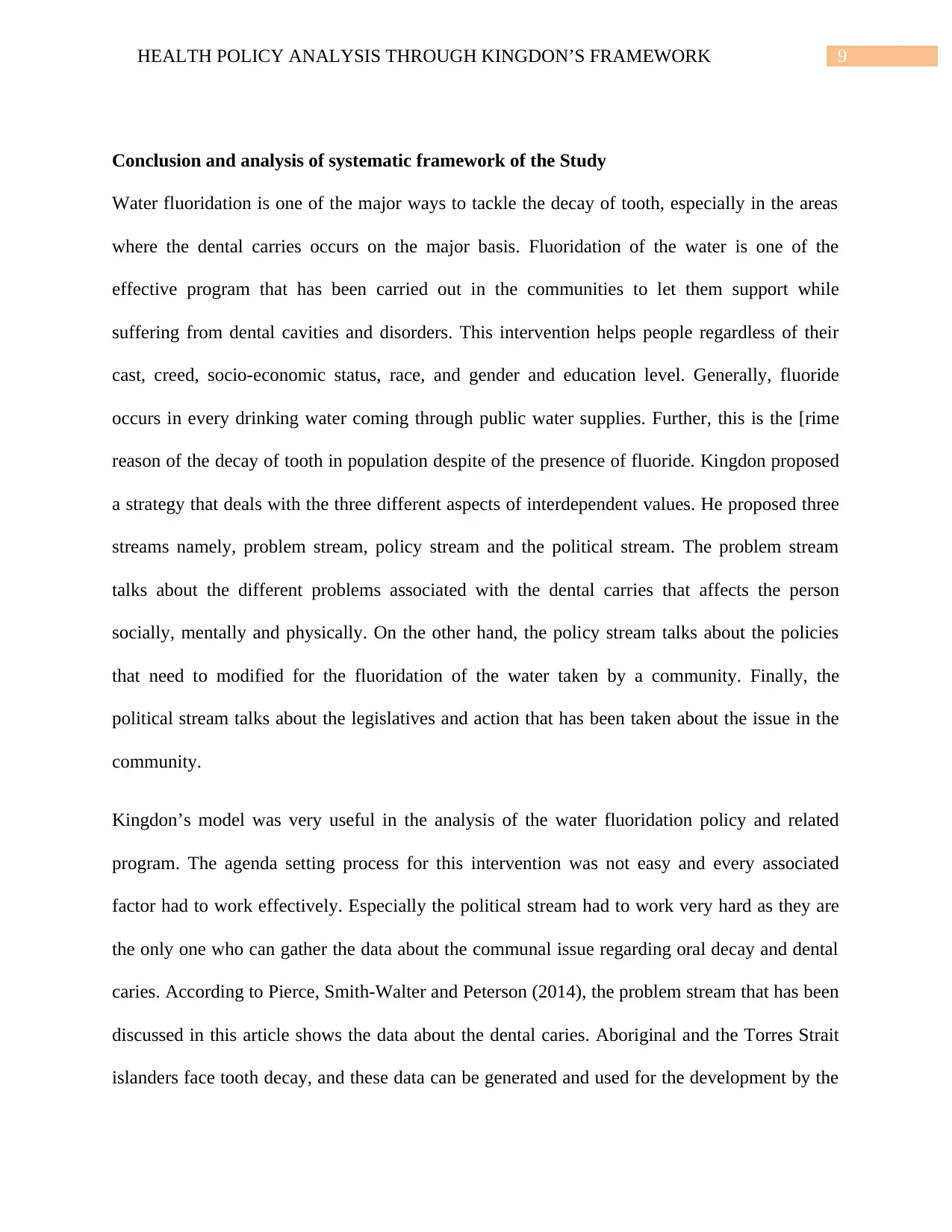
9HEALTH POLICY ANALYSIS THROUGH KINGDON’S FRAMEWORK
Conclusion and analysis of systematic framework of the Study
Water fluoridation is one of the major ways to tackle the decay of tooth, especially in the areas
where the dental carries occurs on the major basis. Fluoridation of the water is one of the
effective program that has been carried out in the communities to let them support while
suffering from dental cavities and disorders. This intervention helps people regardless of their
cast, creed, socio-economic status, race, and gender and education level. Generally, fluoride
occurs in every drinking water coming through public water supplies. Further, this is the [rime
reason of the decay of tooth in population despite of the presence of fluoride. Kingdon proposed
a strategy that deals with the three different aspects of interdependent values. He proposed three
streams namely, problem stream, policy stream and the political stream. The problem stream
talks about the different problems associated with the dental carries that affects the person
socially, mentally and physically. On the other hand, the policy stream talks about the policies
that need to modified for the fluoridation of the water taken by a community. Finally, the
political stream talks about the legislatives and action that has been taken about the issue in the
community.
Kingdon’s model was very useful in the analysis of the water fluoridation policy and related
program. The agenda setting process for this intervention was not easy and every associated
factor had to work effectively. Especially the political stream had to work very hard as they are
the only one who can gather the data about the communal issue regarding oral decay and dental
caries. According to Pierce, Smith-Walter and Peterson (2014), the problem stream that has been
discussed in this article shows the data about the dental caries. Aboriginal and the Torres Strait
islanders face tooth decay, and these data can be generated and used for the development by the
Conclusion and analysis of systematic framework of the Study
Water fluoridation is one of the major ways to tackle the decay of tooth, especially in the areas
where the dental carries occurs on the major basis. Fluoridation of the water is one of the
effective program that has been carried out in the communities to let them support while
suffering from dental cavities and disorders. This intervention helps people regardless of their
cast, creed, socio-economic status, race, and gender and education level. Generally, fluoride
occurs in every drinking water coming through public water supplies. Further, this is the [rime
reason of the decay of tooth in population despite of the presence of fluoride. Kingdon proposed
a strategy that deals with the three different aspects of interdependent values. He proposed three
streams namely, problem stream, policy stream and the political stream. The problem stream
talks about the different problems associated with the dental carries that affects the person
socially, mentally and physically. On the other hand, the policy stream talks about the policies
that need to modified for the fluoridation of the water taken by a community. Finally, the
political stream talks about the legislatives and action that has been taken about the issue in the
community.
Kingdon’s model was very useful in the analysis of the water fluoridation policy and related
program. The agenda setting process for this intervention was not easy and every associated
factor had to work effectively. Especially the political stream had to work very hard as they are
the only one who can gather the data about the communal issue regarding oral decay and dental
caries. According to Pierce, Smith-Walter and Peterson (2014), the problem stream that has been
discussed in this article shows the data about the dental caries. Aboriginal and the Torres Strait
islanders face tooth decay, and these data can be generated and used for the development by the
Paraphrase This Document
Need a fresh take? Get an instant paraphrase of this document with our AI Paraphraser
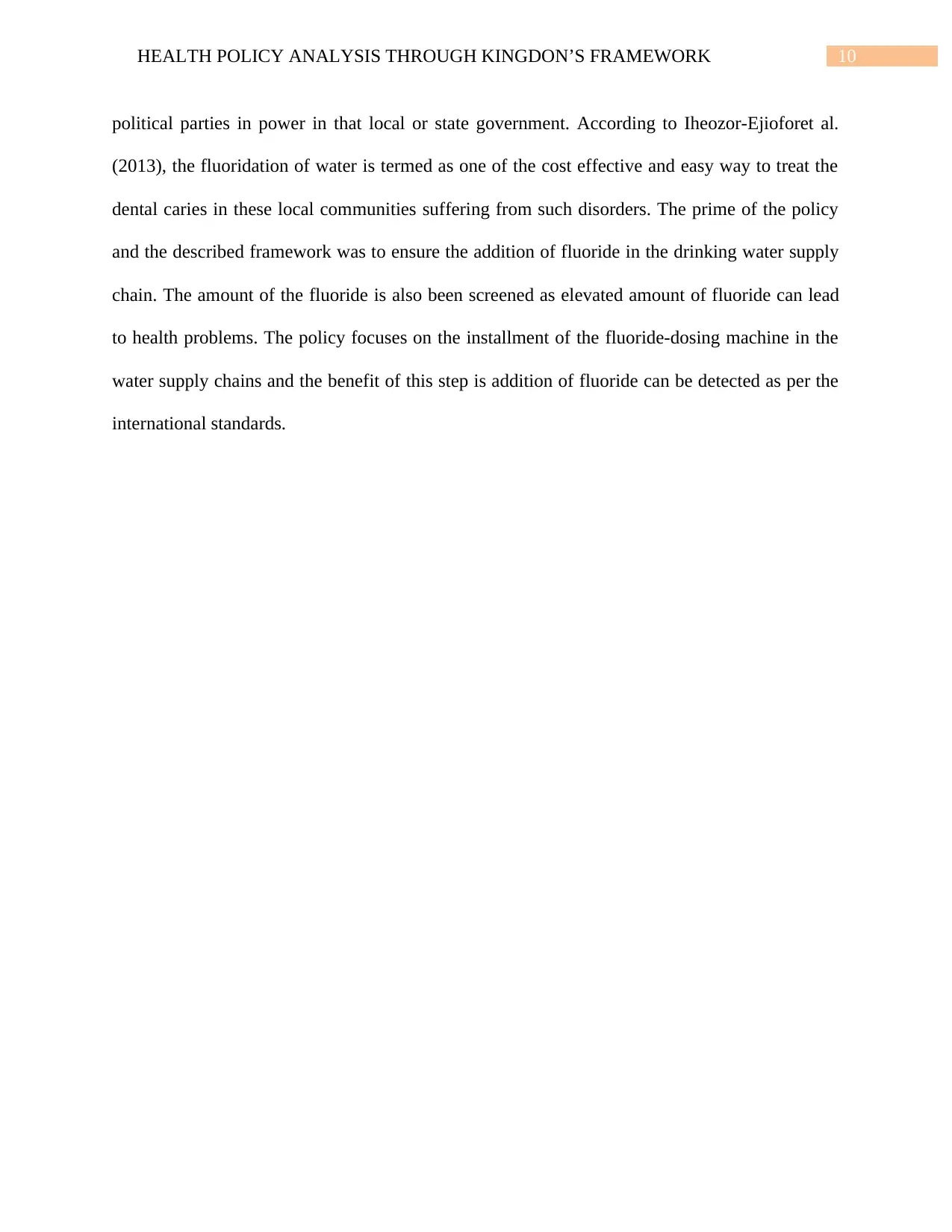
10HEALTH POLICY ANALYSIS THROUGH KINGDON’S FRAMEWORK
political parties in power in that local or state government. According to Iheozor-Ejioforet al.
(2013), the fluoridation of water is termed as one of the cost effective and easy way to treat the
dental caries in these local communities suffering from such disorders. The prime of the policy
and the described framework was to ensure the addition of fluoride in the drinking water supply
chain. The amount of the fluoride is also been screened as elevated amount of fluoride can lead
to health problems. The policy focuses on the installment of the fluoride-dosing machine in the
water supply chains and the benefit of this step is addition of fluoride can be detected as per the
international standards.
political parties in power in that local or state government. According to Iheozor-Ejioforet al.
(2013), the fluoridation of water is termed as one of the cost effective and easy way to treat the
dental caries in these local communities suffering from such disorders. The prime of the policy
and the described framework was to ensure the addition of fluoride in the drinking water supply
chain. The amount of the fluoride is also been screened as elevated amount of fluoride can lead
to health problems. The policy focuses on the installment of the fluoride-dosing machine in the
water supply chains and the benefit of this step is addition of fluoride can be detected as per the
international standards.
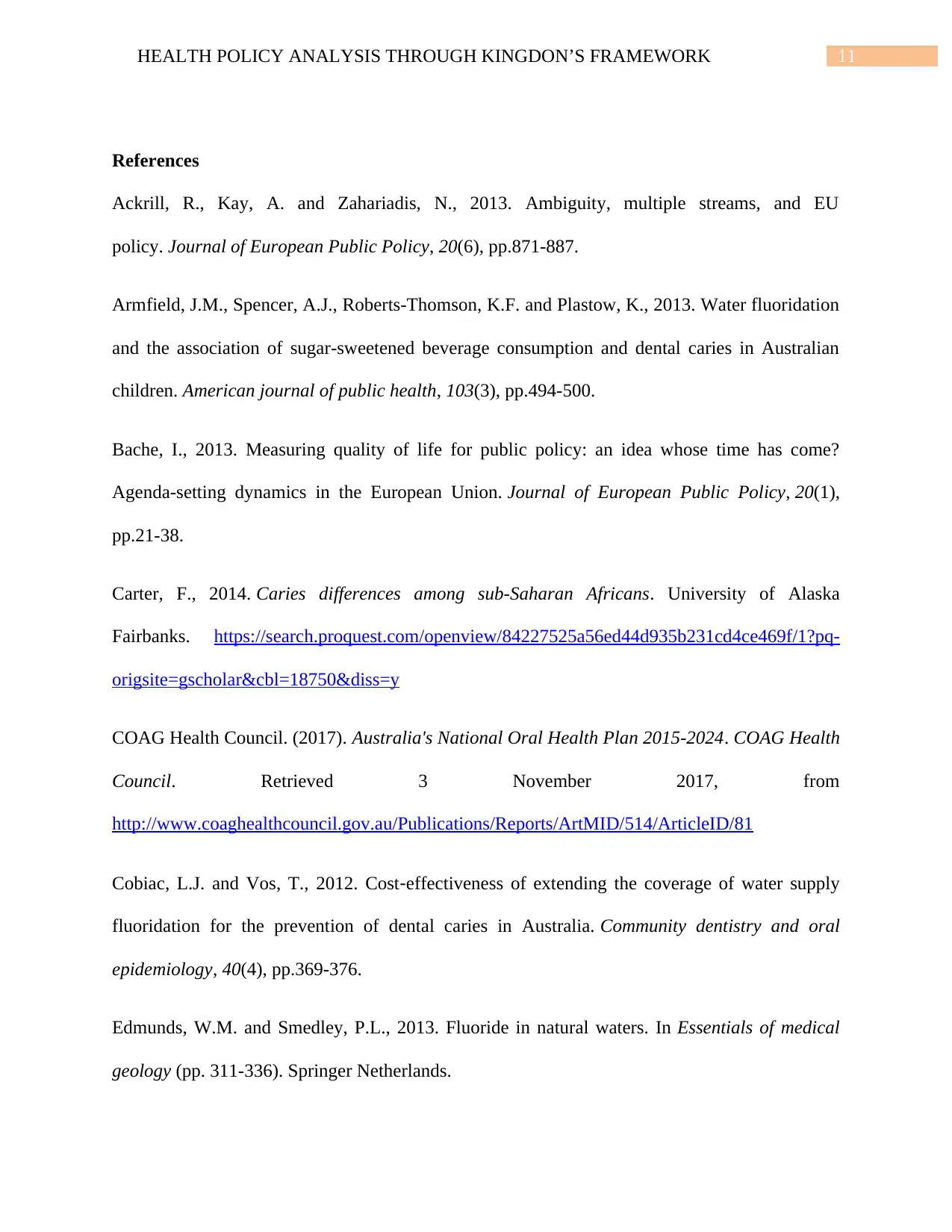
11HEALTH POLICY ANALYSIS THROUGH KINGDON’S FRAMEWORK
References
Ackrill, R., Kay, A. and Zahariadis, N., 2013. Ambiguity, multiple streams, and EU
policy. Journal of European Public Policy, 20(6), pp.871-887.
Armfield, J.M., Spencer, A.J., Roberts-Thomson, K.F. and Plastow, K., 2013. Water fluoridation
and the association of sugar-sweetened beverage consumption and dental caries in Australian
children. American journal of public health, 103(3), pp.494-500.
Bache, I., 2013. Measuring quality of life for public policy: an idea whose time has come?
Agenda-setting dynamics in the European Union. Journal of European Public Policy, 20(1),
pp.21-38.
Carter, F., 2014. Caries differences among sub-Saharan Africans. University of Alaska
Fairbanks. https://search.proquest.com/openview/84227525a56ed44d935b231cd4ce469f/1?pq-
origsite=gscholar&cbl=18750&diss=y
COAG Health Council. (2017). Australia's National Oral Health Plan 2015-2024. COAG Health
Council. Retrieved 3 November 2017, from
http://www.coaghealthcouncil.gov.au/Publications/Reports/ArtMID/514/ArticleID/81
Cobiac, L.J. and Vos, T., 2012. Cost‐effectiveness of extending the coverage of water supply
fluoridation for the prevention of dental caries in Australia. Community dentistry and oral
epidemiology, 40(4), pp.369-376.
Edmunds, W.M. and Smedley, P.L., 2013. Fluoride in natural waters. In Essentials of medical
geology (pp. 311-336). Springer Netherlands.
References
Ackrill, R., Kay, A. and Zahariadis, N., 2013. Ambiguity, multiple streams, and EU
policy. Journal of European Public Policy, 20(6), pp.871-887.
Armfield, J.M., Spencer, A.J., Roberts-Thomson, K.F. and Plastow, K., 2013. Water fluoridation
and the association of sugar-sweetened beverage consumption and dental caries in Australian
children. American journal of public health, 103(3), pp.494-500.
Bache, I., 2013. Measuring quality of life for public policy: an idea whose time has come?
Agenda-setting dynamics in the European Union. Journal of European Public Policy, 20(1),
pp.21-38.
Carter, F., 2014. Caries differences among sub-Saharan Africans. University of Alaska
Fairbanks. https://search.proquest.com/openview/84227525a56ed44d935b231cd4ce469f/1?pq-
origsite=gscholar&cbl=18750&diss=y
COAG Health Council. (2017). Australia's National Oral Health Plan 2015-2024. COAG Health
Council. Retrieved 3 November 2017, from
http://www.coaghealthcouncil.gov.au/Publications/Reports/ArtMID/514/ArticleID/81
Cobiac, L.J. and Vos, T., 2012. Cost‐effectiveness of extending the coverage of water supply
fluoridation for the prevention of dental caries in Australia. Community dentistry and oral
epidemiology, 40(4), pp.369-376.
Edmunds, W.M. and Smedley, P.L., 2013. Fluoride in natural waters. In Essentials of medical
geology (pp. 311-336). Springer Netherlands.
⊘ This is a preview!⊘
Do you want full access?
Subscribe today to unlock all pages.

Trusted by 1+ million students worldwide
1 out of 14
Related Documents
Your All-in-One AI-Powered Toolkit for Academic Success.
+13062052269
info@desklib.com
Available 24*7 on WhatsApp / Email
![[object Object]](/_next/static/media/star-bottom.7253800d.svg)
Unlock your academic potential
Copyright © 2020–2025 A2Z Services. All Rights Reserved. Developed and managed by ZUCOL.



